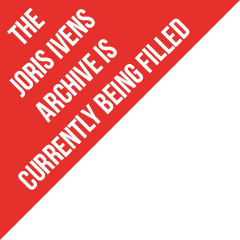

Museo Reina Sofia in Madrid presenteert een film programma getiteld “Por un cine imposible. Documental y vanguardia en Cuba (1959-1972)” (“Voor een onmogelijk cinema. Documentaire en avant-garde in Cuba (1959-1972)”), van 20 juni tot 9 juli 2016. Curator is de Michael Chanan, specialist op het gebied vabn de Cubaanse cinema, met steun van de Cinemateca de Cuba. De twee films die Joris Ivens er gemaakt heeft Carnet de viaje y Cuba en Pueblo armado worden vertoond naast films van Santiago Álvarez, Sara Gómez, Octavio Cortázar en Julio García Espinosa.
This film program dedicated to an episode of the vanguard in Latin America which usually has been ignored: the Cuban documentary movement around the Revolution. This program shows original formats from the ICAIC, the International Filmcenter of Cuba fow which Ivens made two films in 1961. Carnet de viaje is a road movie, crossing around the Cuban island, presenting the revolutionary spirit in various cities, regions and files of labour. Pueblo armado shows the militant spirit of the Cuban workers and farmers to protect and defend their socialist country.
Museo Reina Sofía presents this retrospective film-program dedicated to Cuban documentary movement around the Revolution, an Avant-garde episode in Latin America usually ignored. Together with the impulse to show a new reality and rethink the public function of the image, the documentary in Cuba merges the factual record with the aesthetics of shock and agitation of the montage, producing a unique visual manifesto. The program, with original cinema formats from the ICAIC, is articulated in dialogue with the exhibition dedicated to the artist Wifredo Lam(from 6th April to 15th August 2016).
In 1959, Cuban reality changed radically with the triumph of the Revolution, and one of the consequences was the birth of a new cinema, in which the documentary figured centrally. Barely a decade later, one of its leading figures, Julio García Espinosa, wrote a manifesto calling “Por un cine imperfecto” (For an imperfect cinema), a polemical reflection on the practice of revolutionary film, where he argued that the imperfections of a low budget cinema of urgency, which sought to create a dialogue with its audience, were preferable to the sheen of high production values which merely reflected the audience back to itself. It was a thesis he demonstrated in his own documentary, Tercer mundo, tercera guerra mundial, shot in Vietnam in 1968, which is one of the centrepieces of this season, but it is also manifest in the experimental current which runs through many of the others.
The new documentary that emerged in Cuba in the 1960s involves a paradox. The moment was one in which the appearance of new synchronous 16mm cameras in the metropolitan countries stimulated the aesthetic revolution of direct cinema and cinéma vérité, but not in Cuba, where the new film institute, the ICAIC (Instituto Cubano del Arte y Industria Cinematográficos), being geared to cinema exhibition, stuck with 35mm. They quickly learnt to overcome its limitations. The Revolution unleashed a frenzy of creative endeavour as the enthusiastic new filmmakers went out onto the streets to document their rapidly transforming world, which thus became a forcing ground for the documentary as they tried to keep up.
At the core of the season, the boldest innovator, Santiago Álvarez, was in charge of the weekly Noticiero, which he soon transformed. Instead of an arbitrary sequence of disconnected items, he joined them up into a political argument, or turned them into single topic documentaries, and then proceeded to longer films. Audiences flocked to see his fast, strongly montage-driven style of political satire, usually directed against US international politics, just when documentary was disappearing from metropolitan cinema screens. Alvarez also turned the newsreels into a school for young film-makers in how to make films quickly, cheaply, and using whatever materials were at hand. Their imagination fired up, they became, among other things, masters of working with found footage.
To counterpoint the Cuban films are a handful of documentaries made in Cuba by filmmakers coming from abroad in the Revolution's early years. Joris Ivens eagerly accepted the ICAIC's invitation to make two films with them, while others, including Chris Marker and Agnès Varda, came and made films of their own which stand as timely testimonies of solidarity.
To sum up, the series seeks to present an ignored movement in the histories of avant-garde cinema, but foundational in the critical transformation of the documentary in a medium which negotiates with a historical moment while examines its own limits and possibilities.
Film series dedicated to Julio Garcia Espinosa (Havana, 1926-2016)
In collaboration with the Cinemateca de Cuba
For more information, see: http://www.museoreinasofia.es/en/activities/impossible-cinema-documentary-and-avant-garde-cuba-1959-1972
